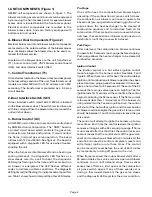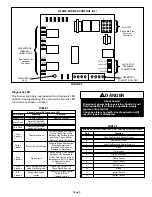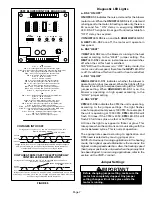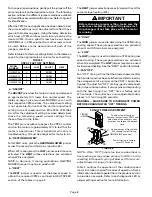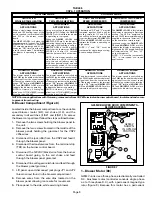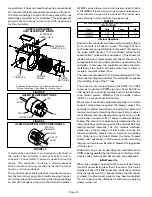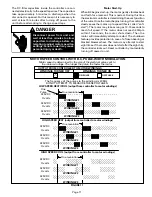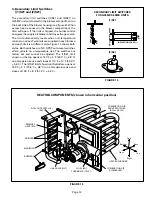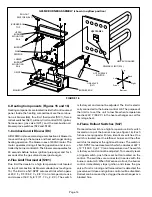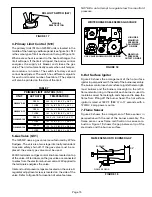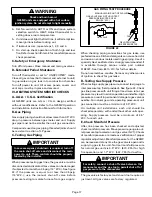
Page 6
TABLE 3
BURNER CONTROL A3 TERMINAL DESIGNATIONS
Terminal
Type
Function
24VAC OUT
1/4” Spade
24VAC Out To VSP2
24VAC HOT
1/4” Spade
24VAC In From Transformer
24VAC RTN
1/4” Spade
24VAC In From VSP2
GROUND
1/4” Spade
To Cabinet Ground
G
Screw Strip
Blower Demand
DS
Screw Strip
Input Harmony Zone Control
Y1
Screw Strip
First Stage Cooling Demand
Y2
Screw Strip
Second Stage Cooling Demand
C
Screw Strip
24VAC Common
W2
Screw Strip
Second Stage Heating Demand
W1
Screw Strip
First Stage Heating Demand
R
Screw Strip
24VAC to Thermostat
G
1/4” Spade
Blower Demand to VSP2
DS
1/4” Spade
Harmony Zone To VSP2
IDR HI
1/4” Spade
120VAC Out To High Speed
Combustion Air Blower (B6)
IDR LO
1/4” Spade
120VAC Out To Lo Speed
Combustion Air Blower (B6)
120VAC RTN
1/4” Spade
120VAC Return From
Combustion Air Blower (B6)
120VAC RTN
1/4” Spade
120VAC Return From (T1)
120VAC HOT
1/4” Spade
120VAC In From Door
Interlock Switch (S51)
120VAC HOT
1/4” Spade
120VAC Output To Control
Transformer (T1)
120VAC HOT
1/4” Spade
120VAC To Blower Motor (B3)
ACCA
1/4” Spade
Accessory Cooling Terminal
ACCH
1/4” Spade
Accessory Heating Terminal
TERM #12
1/4” Spade
24VAC Accessory Input
S102 IN
1/4” Spade
24VAC In From High Fire
Pressure Switch
HI VLV
1/4” Spade
24VAC Out To Gas Valve (GV1)
S101 IN
1/4” Spade
24VAC In From Flue Thermostat
S101 OUT
1/4” Spade
24VAC Out To Flue Thermostat
VSP #3
1/4” Spade
Second Stage Heat Output–VSP2
VSP #5
1/4” Spade
Limit Output To VSP2
4–VSP2 Blower Control Board (A24)
G25MV units are equipped with a variable speed motor
that is capable of maintaining a specified CFM through-
out the external static range. The unit uses the VSP2–1
variable speed control board, located on the blower
access door, which controls the blower speed and
provides diagnostic LEDs. The control has both a
non–adjustable, factory preset “ON” fan timing delay and
an adjustable “OFF” fan timing delay (see figure 6).
The VSP2–1 also senses limit trip condition and turns on
the blower. The G25MV limit switch is located in the
middle of the vestibule wall. When excess heat is sensed
in the heat exchanger, the limit switch will open and
interrupt the current to the gas valve, while at the same
time the VSP2–1 energizes the blower on heating speed.
The limit automatically resets when the unit temperature
returns to normal and the blower is de–energized.
Diagnostic LEDs located on the VSP2–1 control board are
provided to aid in identifying the unit’s mode of operation.
Certain scenarios will arise depending on the jumper
positions. Refer to figure 4 for identification.
IMPORTANT
24 VAC half wave rectified (DC pulse), when
measured with a meter, may appear as a lower
or higher voltage depending on the make of
the meter. Rather than attempting to measure
the output voltage of A24, see G25MV BLOWER
& VSP2 BLOWER CONTROL BOARD TROUBLE-
SHOOTING FLOW CHART in the TROUBLE-
SHOOTING section of this manual.
JP2
HIGH
LOW
ADJUST
HEAT
CFM
HI/LOW
ON/OFF
HEAT
HTG.
BLOWER
1
2
DS2
DS3
DS1
DS4
1
2
3
4
1
2
3
4
1
2
3
4
TEST
–
+
NORM
210
150
90
270
JP1
VSP2–1 VARIABLE SPEED CONTROL BOARD SELECTIONS
FIGURE 4
DIAGNOSTIC
DS LEDS
FAN “OFF”
TIMING PINS
JP46
13 PIN PLUG
(BOARD TO MOTOR)
HEATING STAGE
JUMPER SELECTOR PINS
JP73
15 PIN PLUG
(BOARD TO VARIOUS
POINTS IN FURNACE)
HIGH SPEED
SELECTOR PINS
(COOLING ONLY)
LOW SPEED
SELECTOR PINS
(COOLING AND HEATING)
HEATING SPEED
SELECTOR PINS
OPERATIONAL
SELECTOR PINS
(Affects both heating
and cooling modes)
1
1




